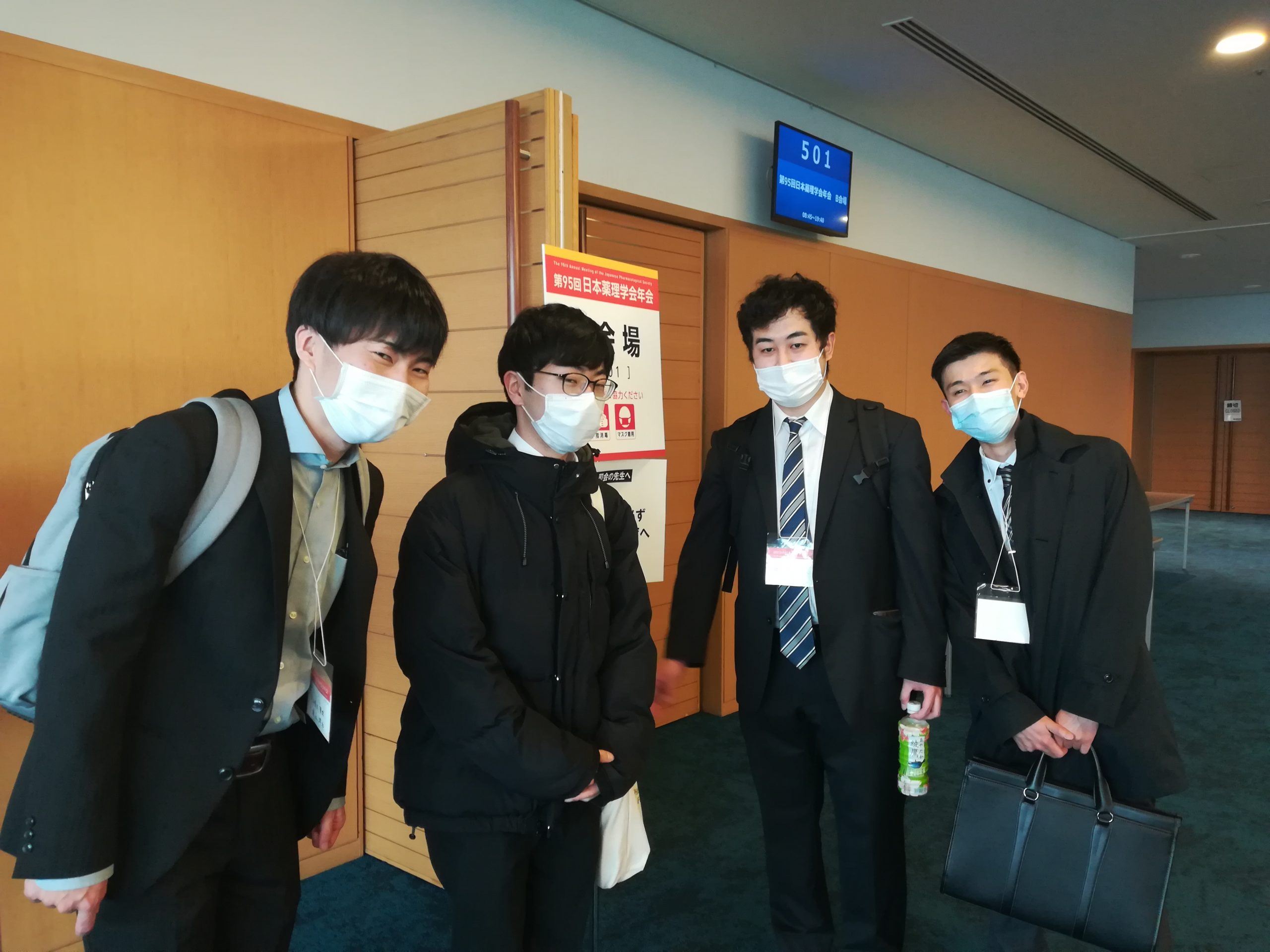山梨大学医学科5年 薬理学教室所属 濱田健太郎
ライフサイエンスコースおよび薬理学教室のサポートのもと第95回日本薬理学会年会に参加させていただいた。来年度は学業や進路の問題で忙しいためおそらく今回が学生生活において最後の学会発表であったと思うが山梨大学のサポートのもとたくさんの経験をさせていただいたため緊張せずに有意義な発表ができた。新型コロナウイルスに関連する問題のせいで何度も学会がオンライン開催になり現地で実際に参加できたのは数回しかなかったがライフサイエンスコースに所属し研究させていただいたことで学生生活を通して貴重な体験を何度もさせていただけたと感じている。
今回の学会でディスカッションや指摘いただいた点をブラッシュアップしてより良い研究が報告できるように残り少ない学生生活だが研究活動を頑張っていきたいと思う。
以下に発表の抄録を示す。
Glaucoma is a leading cause of blindness worldwide, which is caused by the degeneration of retinal ganglion cells (RGCs). An elevated intraocular pressure (IOP) is widely recognized as one of the major risk factors for glaucoma. We have reported that purinergic P2Y1 receptor is essential for IOP reduction and P2Y1 receptor knockout (P2Y1KO) mice show hypertensive glaucoma-like phenotype. We already reported that P2Y1 receptor is located in ciliary body(CB) and trabecular meshwork (TM), and controls production and outflow of aqueous humor, respectively. We also found that ocular hypertension itself did not solely cause RGC degeneration at young ages, so we hypothesized IOP-independent pathogenic mechanism. Immunohistochemical analysis revealed that P2Y1 receptors were expressed in Müller cells in the retina in addition to CB and TM. To test the role of P2Y1 receptors in Müller cells for RGC damages, we made Mlc1-tTS::P2ry1tetO/tetO mice (Müller cell-specific P2Y1 receptor conditional knockout mice; MC-cKO). We measured the IOP of control (P2ry1tetO/tetO) and MC-cKO mice and found no difference between them. Next, RGC damage was compared by counting the number of Rbpms-positive cells. Howeve, MC-cKO mice at 12 months old showed significantly higher number of RGCs loss than that in age-matched control mice. Accompanied this, the number of apoptotic cells significantly increased in the MC-cKO mice. Taken together, our results demonstrated that the lack of P2Y1 receptors in Müller cells promotes RGC loss without IOP elevation, suggesting an importance of Müller cells for pathogenesis of glaucoma.
================================================
薬理学講座 医学部5年 小林憲司
これは、さる3/7-3/9に福岡にて開催された第95回日本薬理学会年会への参加に関するものである。ライフサイエンスコースのサポートを受けての参加であったため、ここに報告書を提出する。いつもありがとうございます。
コロナ禍が始まって以降、初の現地での学会参加となった。やはり現地での学会参加はオンラインとは比べるべくもないたくさんの刺激があった。多くの人に出会い、発表の内外で直接議論ができるのは、至上の喜びである。3年前の薬理学会年会が私の学会参加・学会発表デビューであったが、こうして学部最後の年会を対面で終えることができ、とても嬉しく思う。機会があれば、ぜひ舞い戻ってきたい。
加えて、今回学生部門での優秀発表賞をありがたくも受賞することができました。この場を借りて、普段からご指導をいただいている先生方に感謝を申し上げます。
================================================
第95回薬理学会年会参加報告 薬理学教室 檀上洋右
この度はライフサイエンスコースのサポートを受けて日本神経科学大会で口頭発表をさせていただいた。ハイブリッドでの学会であり他の先生方との接点は例年に比して少なかったが、多くの貴重なフィードバックを得られたので、今後の研究に役立てたいと思う。
以下に発表の抄録を示す。
Glial cells are vital for the modulation of synaptic connections and healthy brain development. They control the excitatory / inhibitory synaptic balance and assemble neural circuity by synaptic formation or elimination. We have recently revealed that astrocytes form excitatory synapses in the adult injured brain through mGluR5 signaling. However, astrocytic mGluR5 is, in health brain, expressed in the limited time-window of the postnatal developmental stage. Thus, we surveyed whether and how astrocytic mGluR5 destines the subsequent synaptic assembly using astrocyte-specific mGluR5 KO mice (cKO). Unexpectedly, the number of excitatory synapses did not alter much in cKO, instead, the number of inhibitory synapses decreased significantly in cKO throughout ages. Interestingly, microglia frequently engulfed inhibitory synaptic elements in the critical period in cKO. Astrocytic mGluR5 expression were transient event in the critical period, however, behavioral dysfunction was observed in adult cKO mice. Next, we surveyed the astrocytic molecule which regulates microglial engulfment. We focused on IL7, which is decreased in cKO, as a candidate for such molecules. IL7 treatment decreased engulfment-related gene expression in microglia. Hence, we conclude that astrocytes organize inhibitory network in the critical period by modulating microglial phagocytic activity. It should be noted that although mGluR5 is only transiently expressed in astrocytes in the critical period, its function greatly affects the inhibitory neuronal networks throughout life.
================================================
第95回薬理学会年会参加報告 薬理学教室 鈴木秀明
この度はライフサイエンスコースのサポートをうけ、福岡国際会議場にて開催された第95回日本薬理学会年会に参加させていただきました。ハイブリット形式の学会でしたが多数の先生方に自身の発表を聞いていただくことができ、また、多様な演題に触れることができた貴重な機会でした。
以下に発表の抄録を示す。
Astrocytes become reactive upon injury and inflammation in the brain to alter their molecular profiles, morphology and functions. Reactive astrocytes alter the expression of receptors which are responsible for their functions especially communications in neuron-glia and glia-glia. Among such receptors, the expression of P2Y1 receptors (P2Y1) is upregulated in many neurological diseases including epilepsy and Alzheimer’s disease, in which neuronal hyperexcitability is commonly observed. We have previously shown that P2Y1 upregulation in astrocytes trigger neuronal hyperexcitability by enhancing neuron-astrocyte communications. However, the mechanism underlying the upregulation of P2Y1 in astrocytes remains unknown. We investigated the role of microglia in enhanced P2Y1R signaling in astrocytes during pathological conditions. To ask whether microglia play a role in P2Y1 upregulation in astrocytes, we depleted microglia by treatment with PLX5622 and found much larger Ca<SUP>2+</SUP> elevation evoked by a P2Y1 agonist and more P2ry1 transcripts in astrocytes. Microglia depletion enhanced extracellular ATP level presumably through impairment of degradation of ATP. These findings suggest that microglia should has an important role to control P2Y1 receptor expression in astrocytes and negatively regulate neuron-astrocyte communication.


